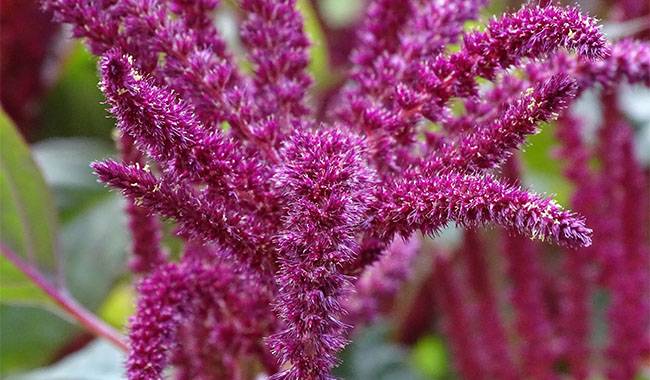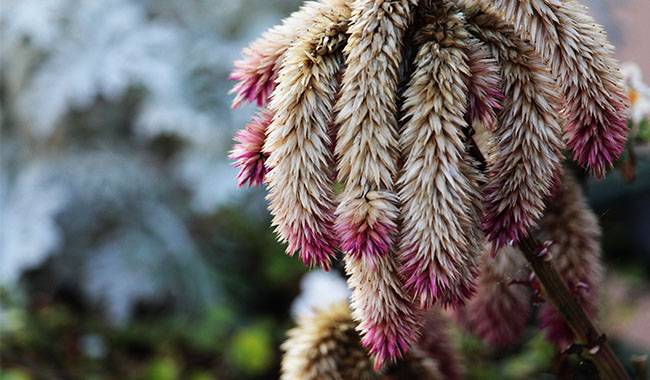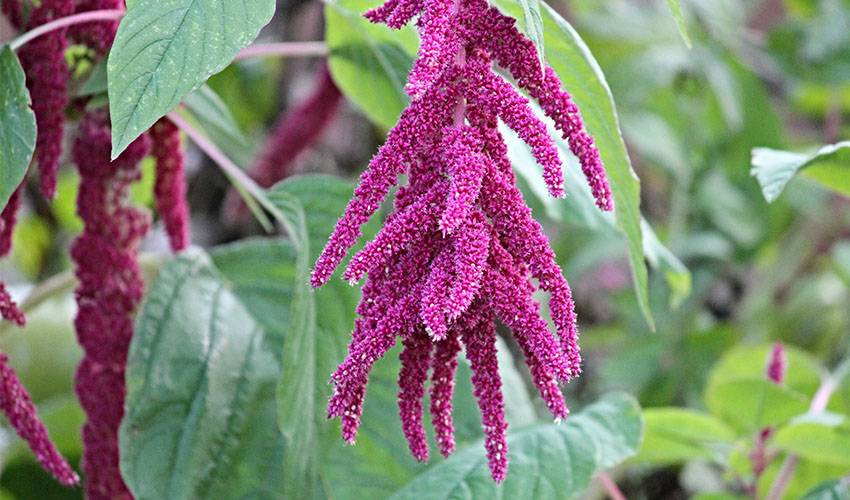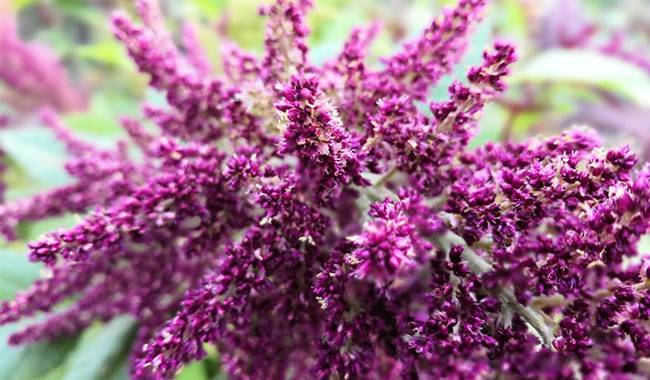
How to grow Amaranthus? This article provides answers to growing Amaranthus and how to care for Amaranthus.
Amaranthus (lat. Amaranthus) plant, or shiri, belongs to the genus Amaranthus in the family Amaranthaceae and is widely distributed in the wild in America, India, and China.
In East Asian countries, Amaranthus tricolor is grown as a vegetable crop, although the same species, such as Amaranthus caudalis and Sadder amaranth, are often used as ornamental plants.
Eight thousand years ago, Amaranthus, together with maize and beans, became one of the main food crops of the Incas and Aztecs who inhabited the territory of modern Mexico and South America.
Some species of Amaranthus, such as Amaranthus horsetail and Amaranthus paniculata, are still grown today as cereal crops, but some species are considered to be weeds – such as blue amaranth grass or Amaranthus tip amaranth.
In East Asian countries, Amaranthus tricolor is grown as a vegetable crop, although Amaranthus tail and Amaranthus sides of the same species are often used as ornamental plants.
Amaranthus flowers were introduced to Europe by Spanish sailors as decorations for flower beds, and from the 18th century onwards, Amaranthus flowers began to be grown as forage or cereal crops.
In Greek, Amaranthus means “the flower of immortality”.
ADVANTAGES AND DISADVANTAGES OF AMARANTHUS
Scientists consider Amaranthus to be the plant of the twenty-first century, capable of feeding and healing all of humanity. This may be an exaggeration, but there is some truth to the statement.
All parts of Amaranthus are edible, nutritious, and very useful, but the most valuable product is Amaranthus seeds.
Amaranthus seeds are very useful because they contain an entire complex of essential fatty acids for humans – stearic, oleic, linoleic, and palmitic acids – a property of Amaranthus that allows it to be used in dietary products.
Amaranthus also contains squalene, vitamins B, C, D, P, E, rutin, carotenoids, steroids, bile and pantothenic acid, and many other substances essential for human health.
Amaranthus leaves are as nutritious as spinach but far superior in protein. amaranthus leaf protein contains the essential amino acid lysine in almost the same amount as soybeans, but amaranthus is easier to digest than soybeans, wheat, or corn.
The Japanese compare Amaranthus to squid meat and believe that daily consumption of Amaranthus can rejuvenate and rejuvenate the body.
Not only are the leaves of the vegetable Amaranthus edible, but ornamental and plant varieties are equally rich in vitamins, proteins, and trace elements. However, it is better not to eat the seeds of ornamental plants. By the way, it is easy to distinguish medicinal and ornamental Amaranthus from seeds – seeds of medicinal and vegetable varieties are lighter than seeds of ornamental varieties.
Amaranthus oil is the most valuable of the plant oils, more than twice the healing power of sea buckthorn. Creams and masks based on Amaranthus oil rejuvenate and tone the skin and provide antibacterial protection.
Sprouted Amaranthus seeds have the same constituent value as breast milk. They are commonly used not only in medicine but also in cooking.
The usefulness of Amaranthus, with its leaves in tea, can treat obesity, arteriosclerosis, neurosis, dysentery. amaranthus leaves and grains are effective in treating the liver and kidneys, treating adenomas, cardiovascular diseases, and inflammatory diseases of the urinary system.
The properties of Amaranthus, in its constant use in food help to cope with even malignant tumors, as well as to strengthen the immune system.
By adding Amaranthus leaves to a summer salad, you can prolong your life and improve your health. Adding Amaranthus seed powder to wheat flour improves the texture of baked goods and slows down the hardening process of muffins.
Toasted Amaranthus seeds are very tasty and nut-like, and are great for sprinkling on buns and bread meat. Add an Amaranthus leaf to a three-liter jar and you’ll keep your cucumbers crisp and firm until spring.
GROWING AND CARING FOR AMARANTHUS
Planting: Sowing seeds in the ground – late April or late May; sowing seedlings – late March and transplanting seedlings into the ground – mid to late May.
Flowering: from June to frost.
Lighting: full sunlight.
Soil: light, nutrient-rich, calcareous, not too wet, not too acidic soil.
Watering: During the rooting process of seedlings – constant watering, watering is only necessary in case of prolonged drought.
Fertilization: 3-4 times per season with cowpea solution, preferably in the evening.
Propagation: Seeds.
Insect pests: aphids, weevil larvae.
Diseases: root gray mold, powdery mildew, rust.
Nature: All parts of Amaranthus are edible and useful.
BOTANICAL DESCRIPTION
Amaranthus stems may be solitary or branched, with alternate, entire, lance-shaped, ovate, or rhombic leaves, the base of the leaf blade elongated into a petiole, and the leaf apex hollow and slightly pointed. The gold, red, green, and purple axillary flowers are arranged in bunches, while the apical ones are arranged in spike-like panicles.
The fruit of Amaranthus is a capsule with small seeds. The plants come in green, purple, and violet colors, and sometimes these colors are combined in one plant. Depending on the species, Amaranthus may reach a height of 12inch (30cm) or even 120inch (3m). In our climate, Amaranthus is grown as an annual plant.
GROWING AMARANTHUS FROM SEEDS
How to sow seeds
Planting Amaranthus is not difficult. At the end of April in places where the soil at a depth of 1.5-2inch (4-5 cm) has been warmed by the sun to 50 °F (10ºC), you can sow Amaranthus seeds directly into the ground, but before that should be prepared for planting place – make a dig under 30 grams of mineral mix or compound fertilizer per square meter according to the instructions.
However, when incorporating fertilizers into the ground, be careful: Amaranthus easily converts nitrogen fertilizers into dangerous nitrates, so do not overdo the nitrogen content. If you sow Amaranthus in time, it will grow quickly and you won’t have to fight with weeds.
So, at the end of April, sow the seeds one by one in a furrow in moist soil and embed them to a depth of 0.6inch (1.5cm). For convenience, fine seeds can be mixed with sand or sawdust at a ratio of 1:20 – this makes it easier to sow.
The observation distance between rows is 18inch (45 cm) and there should be about 2.8-4inch (7-10 cm) between specimens, so experienced flower growers like to tangle the seeds for sowing, but don’t mix the seeds with the sand, but spread them out one by one.
You will see sprouting after 8-10 days, and if necessary, you need to thin the seedlings and loosen the soil between the thinning. If you plant Amaranthus later, in May, you still have to fight weeds.
When Amaranthus grows to 8inch (20 cm) high, fertilize with nitrogen fertilizer, but at half the concentration recommended by the manufacturer. It doesn’t matter whether you grow vegetable or decorative amaranth, it will be fully matured in three to three and a half months from the time of sowing.
SEEDLING CARE
The conditions for growing Amaranthus by the seedling method will not be difficult for you. Amaranthus seeds should be sown for seedlings at the end of March. Plastic containers or ordinary pots for seedlings up to 4inch (10cm) tall are fine.
Sow the seeds in 0.6-0.8inch (1.5-2cm) of moist soil and place the pot in a warm, bright place. Water the seeds with a sprayer. The optimum temperature for germination is about 71°F (22°C).
If these conditions are observed, sprouts will appear in less than a week. When Amaranthus will germinate, thin out the weak shoots and plant them in individual pots, 4.8inch (12cm) in diameter when the shoots have three leaves each.
PLANTING AMARANTHUS
When to plant
Once the soil in the garden has warmed sufficiently and the threat of returning frost has passed, the seedlings can be planted in the open ground. This is usually done in mid to late May. The growing area should be well-lit and well-drained, with well-lit, nutrient-rich soil and plenty of lime.
By and large, Amaranthus has no requirements at all, but what it does not tolerate are low temperatures and too much water in the soil. Before planting Amaranthus in the open ground, the soil of the plot should be tilled with nitro Amofosca at a rate of 20 grams per 1 square meter.
HOW TO GROW AMARANTHUS
Plant Amaranthus with a distance of 4-12inch (10-30 cm) between specimens and a gap of 18-28inch (45-70 cm) between rows, depending on the species and variety.
Regular watering is required until the seedlings take root and start growing. And be prepared to cover the Amaranthus ground in case the cold weather comes back.
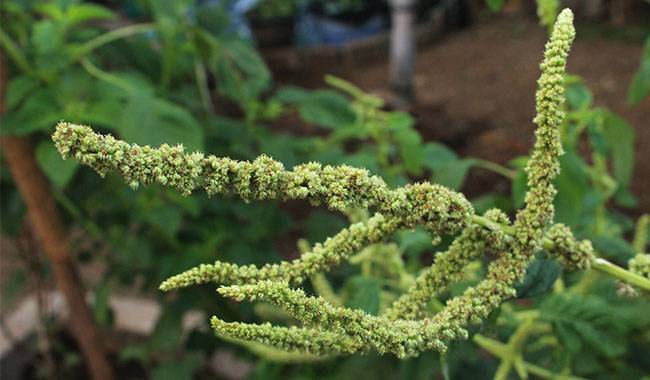
AMARANTHUS CARE
Planting conditions
In fact, Amaranthus care only needs to be done before the plant starts to grow, but the first month Amaranthus seedlings develop very slowly, so they need to be watered, weeded, and loosened.
However, Amaranthus accelerates its development and there is no more place for weeds in the ground. Sometimes an Amaranthus specimen can grow seven centimeters in a day!
Regular watering is also important for Amaranthus, only during its first month of open ground growth, after which the plant’s roots penetrate deep into the soil and watering becomes unnecessary, unless a dry summer rain-free period arrives – then Amaranthus will need watering just like any other plant.
Amaranthus fertilizer is advisable 3-4 times a season, his best fertilizer – a solution of cowpea in the ratio of 1:5 and ash (200 g per 10 liters of water). It is best to water in the early morning after watering.
PESTS AND DISEASES
Planting and caring for Amaranthus will not give you any trouble. In addition, Amaranthus is very resistant to pests and diseases. However, it can be attacked by aphids and weevils. Weevil larvae develop in the stem, thus retarding its growth.
Aphids are only capable of infesting Amaranthus when it first emerges and usually only occur during the humid and rainy summer months. Treating Amaranthus with insecticidal chemicals will exterminate the aphids. The same preparations work well in controlling weevils.
If too much water accumulates in the soil, Amaranthus can become sick from fungal diseases. Treatment is done by spraying the plants with fungicides – colloidal sulfur, copper sulfate, copper chloride, and similar preparations.
AMARANTHUS AFTER FLOWERING
How and when to harvest seeds
If you want to harvest Amaranthus seeds, pick a few of the strongest plants and do not cut the leaves off. Once the lower leaves of Amaranthus have turned red, wilted, and fallen off and the stems have turned white, choose a dry day and cut the inflorescence from the harvested specimen, starting at the base of the stem, and place it in a well-ventilated, dry room to dry.
After a few weeks, when rubbing the dried clover by hand, the mature seeds fall out easily from the capsule, then sift through a fine sieve and store in a box or paper bag. the seeds of Amaranthus do not lose their germination for about 5 years.
AMARANTHUS IN WINTER
Amaranthus in our latitudes is not even tolerant of warm winters, so it is grown as an annual plant. Collect and dispose of the plant remains of Amaranthus at the end of the plant’s growing season.
If you are sure that your Amaranthus is free of pests and diseases, put its haul-offs in a compost pit – it will make a good fertilizer. the ground parts of Amaranthus can also be used as animal feed, such as feed for pigs and poultry, as it contains protein, high amounts of carotene, and vitamin C, in addition to high-quality protein.




